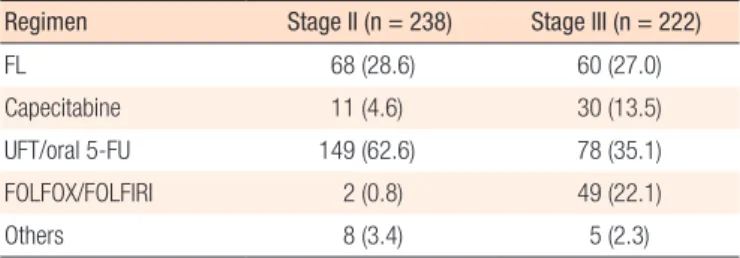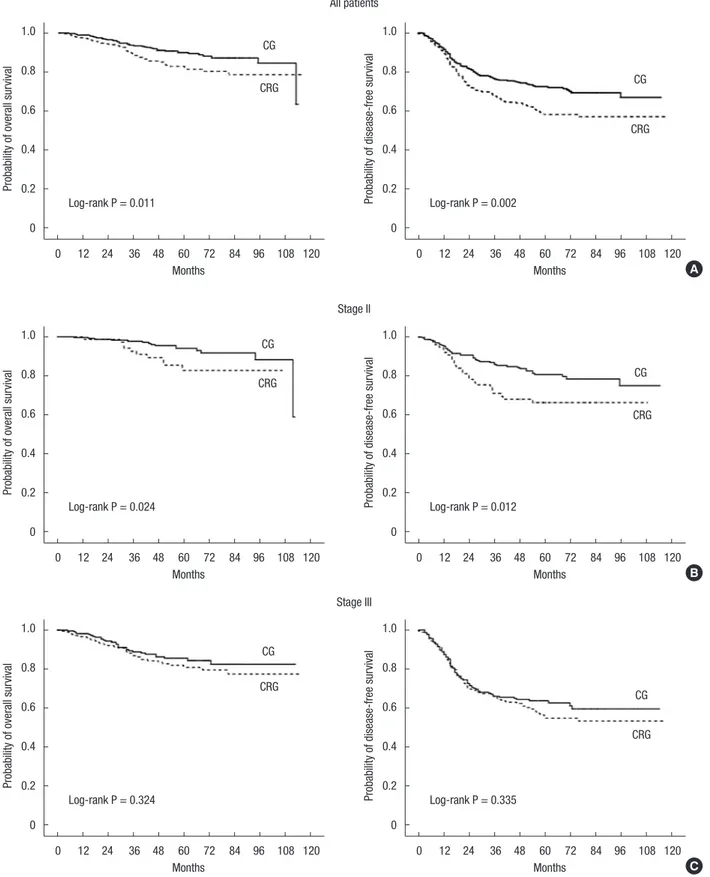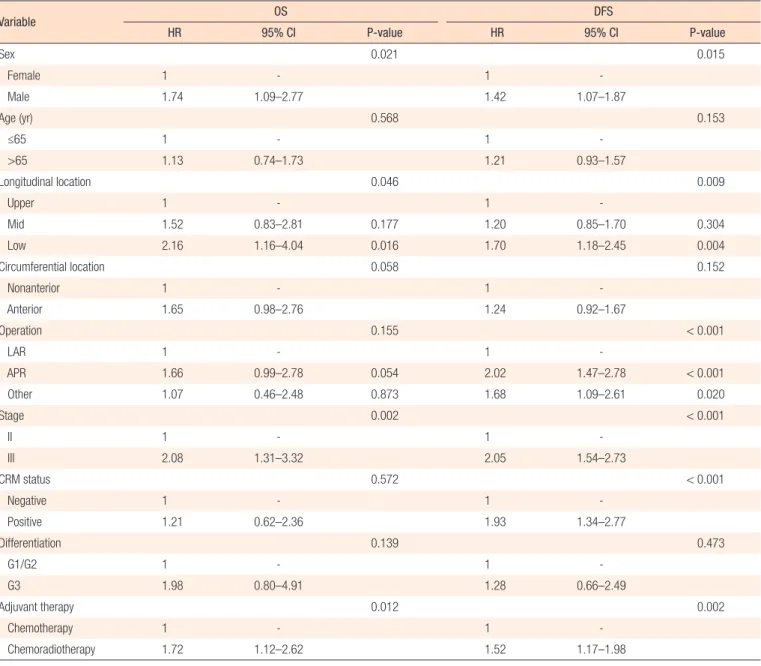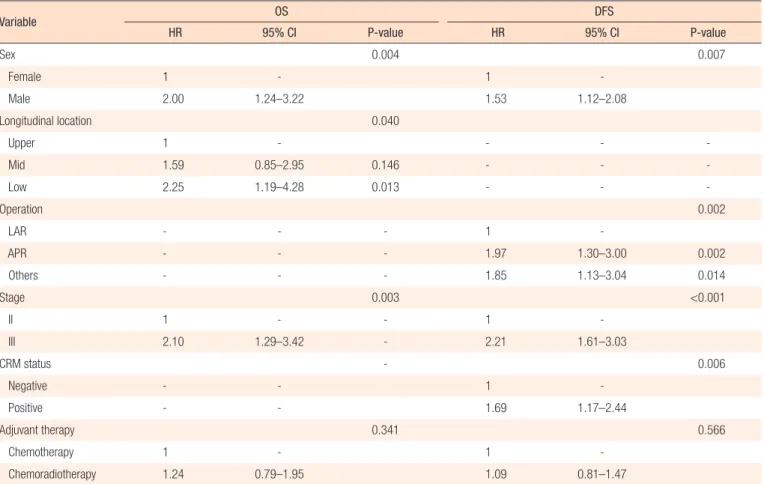pISSN 2287-9714 eISSN 2287-9722 www.coloproctol.org
Impact of Adjuvant Therapy Type on Survival in Stage II/III Rectal Cancer Without Preoperative Chemoradiation: A Korean Multicenter Retrospective Study
Byung Mo Kang
1, Jeong-Heum Baek
2, Sun Jin Park
3, Seong Kyu Baek
4, Ki-Jae Park
5, Hong-Jo Choi
5, Byung-Noe Bae
6, Sun Keun Choi
7, Kap Tae Kim
8, Jin-Su Kim
9, Suk-Hwan Lee
101
Department of Surgery, Hallym University Chuncheon Sacred Heart Hospital, Hallym University College of Medicine, Chuncheon;
2
Department of Surgery, Gachon University Gil Medical Center, Gachon University School of Medicine, Incheon;
3Department of Surgery, Kyung Hee University Medical Center, Kyung Hee University School of Medicine, Seoul;
4Department of Surgery, Keimyung University Dongsan Medical Center, Keimyung University School of Medicine, Daegu;
5Department of Surgery, Dong-A University Hospital, Dong-A University College of Medicine, Busan;
6Department of Surgery, Inje University Sanggye Paik Hospital, Inje University School of Medicine, Seoul;
7Department of Surgery, Inha University Hospital, Inha University School of Medicine, Incheon;
8Department of Surgery, Presbyterian Medical Center, Jeonju;
9Department of Surgery, Chungnam National University Hospital, Chungnam National University College of Medicine, Daejeon;
10Department of Surgery, Kyung Hee University Hospital at Gangdong, Kyung Hee University School of Medicine, Seoul, Korea
Ann Coloproctol 2018;34(3):144-151 https://doi.org/10.3393/ac.2017.09.26.1
Purpose: This study compared the oncologic impact of postoperative chemotherapy and chemoradiotherapy on patients with rectal cancer without preoperative chemoradiation.
Methods: This retrospective study analyzed 713 patients with a mean follow-up of 58 months who had undergone radical resection for stage II/III rectal cancer without preoperative treatment in nine hospitals from January 2004 to December 2009. The study population was categorized a chemotherapy group (CG, n = 460) and a chemoradiotherapy group (CRG, n = 253). Five-year overall survival (OS) and disease-free survival (DFS) were analyzed, and independent factors predict- ing survival were identified.
Results: The patients in the CRG were significantly younger (P < 0.001) and had greater incidences of low rectal cancer (P <
0.001) and stage III disease (P < 0.001). Five-year OS (P = 0.024) and DFS (P = 0.012) were significantly higher in the CG for stage II disease; however, they were not significantly different for stage III disease. In the multivariate analysis, inde- pendent predictive factors were male sex, low rectal cancer and stage III disease for OS and male sex, abdominoperineal resection, stage III disease and tumor-positive circumferential margin for DFS. However, adjuvant therapy type did not independently affect OS (hazard ratio [HR], 1.243; 95% confidence interval [CI], 0.794–1.945; P = 0.341) and DFS (HR, 1.091; 95% CI, 0.810–1.470; P = 0.566).
Conclusion: Adjuvant therapy type did not affect survival of stage II/III rectal cancer patients without neoadjuvant chemoradiotherapy. These results suggest that adjuvant therapy can be chosen based on the patient’s condition and the policies of the surgeons and hospital facilities.
Keywords: Rectal cancer; Adjuvant therapy; Chemotherapy; Chemoradiotherapy; Survival
INTRODUCTION
The standard treatment, under an exact oncologic principle, to cure a patient with rectal cancer is a radical resection with total mesorectal excision. A multimodal strategy with perioperative chemotherapy and radiotherapy might improve survival out- comes. Unlike colon cancer for which adjuvant therapy is recom- mended for patients with stage III and high-risk stage II disease
Received: August 2, 2016
•Accepted: September 26, 2017 Correspondence to: Suk-Hwan Lee, M.D.
Department of Surgery, Kyung Hee University Hospital at Gangdong, Kyung Hee University School of Medicine, 892 Dongnam-ro, Gangdong-gu, Seoul 05278, Korea
Tel: +82-2-440-6134, Fax: +82-2-440-6295, E-mail: leeshdr@khu.ac.kr ORCID code: https://orcid.org/0000-0001-6470-8620
© 2018 The Korean Society of Coloproctology
This is an open-access article distributed under the terms of the Creative Commons Attribution Non- Commercial License (http://creativecommons.org/licenses/by-nc/4.0) which permits unrestricted non- commercial use, distribution, and reproduction in any medium, provided the original work is properly cited.
[1, 2], an optimal sequence for multidisciplinary treatment of pa- tients with stage II/III rectal cancer has not yet been established, although adjuvant radiotherapy with chemotherapy is recom- mended after surgery [3]. The oncologic effect of neoadjuvant ra- diotherapy and the superior local control of concurrent chemora- diotherapy (CCRT) for the treatment of patients with locally ad- vanced rectal cancer have been established [4, 5]. However, insuf- ficient studies have been conducted on the oncologic benefits of combining chemotherapy and radiotherapy compared with che- motherapy alone in a postoperative adjuvant setting. Although the clinical recommendation for patients with stage II/III rectal cancer is preoperative CCRT, not all patients receive preoperative CCRT. The necessity of preoperative CCRT for the treatment of patients with upper rectal cancer is still under debate. In these cir- cumstances, many clinicians have difficulty deciding on postop- erative treatment, especially for patients with circumferential- margin-negative stage II/III rectal cancer. The aim of this study was to identify survival differences for patients receiving chemo- therapy alone or chemoradiation as an adjuvant therapy for stage II/III rectal cancer.
METHODS
This study was a multicenter, retrospective analysis. Records from January 2004 to December 2009 were reviewed for patients who had undergone radical surgery for pathological stage II/III rectal cancer at 9 hospitals in Korea. All were followed postoperatively for more than 12 months. The definition of rectal cancer was an adenocarcinoma within 15 cm of the anal verge. Exclusion crite- ria were (1) neoadjuvant radiation with or without chemotherapy, (2) 30-day mortality, (3) other intraabdominal malignancy within the last 5 years, or (4) malignancy associated with familial adeno- matous polyposis or hereditary nonpolyposis colorectal cancer.
The reason patients did not undergo neoadjuvant radiation was patient refusal in most cases and was unclear in other cases. Re- cords for 823 patients with rectal cancer were collected from the 9 hospitals. After the data had been reviewed, 110 patients were ex- cluded: 56 did not receive any adjuvant therapy, 6 received radio- therapy without concurrent chemotherapy and 48 were lost to follow-up.
This multicenter, retrospective study was approved by the Insti- tutional Review Board at each hospital. Data were collected from a prospective patient registry or a review of hospital charts and accumulated through a newly designed case-reporting form. The following variables were recorded: (1) baseline characteristics of the patient and the tumor (sex, age, body mass index, American Society of Anesthesiologists physical status classification, longitu- dinal and circumferential location of tumor); (2) treatment and pathological data (operation date, operation name, pT category, pN category, number of harvested lymph nodes, status of circum- ferential resection margin [CRM], tumor differentiation, and type of adjuvant therapy); and (3) oncologic data (recurrence, date of
recurrence, death, and date of last follow-up).
Longitudinal locations of tumors were stratified by distance to the anal verge into low rectal cancer within 0 to 5.0 cm, mid rectal cancer within 5.1 to 10.0 cm and upper rectal cancer within 10.1 to 15.0 cm. Circumferential locations of tumors were classified into four quadrants as anterior (12 o’clock), right lateral (9 o’clock), posterior (6 o’clock) or left lateral (3 o’clock). Circumferential tu- mors were defined as those that were more than 75% of the cir- cumference of the rectal diameter. Tumor locations were recate- gorized into 2 distinct positions: anterior for tumors in an anterior and circumferential location and nonanterior for tumors in both lateral and posterior locations. Pathological staging and histologi- cal grading of rectal cancers were recorded according to the sev- enth edition of the American Joint Commission on Cancer Can- cer Staging manual, and tumor-positive CRM was defined as a circumferential margin less than 1 mm from the tumor.
Eligible patients were divided into an adjuvant chemotherapy group (CG) and an adjuvant chemoradiotherapy group (CRG).
The CG included patients who had received a chemotherapeutic agent for more than 6 cycles or 3 months. Chemotherapeutic agents were chosen based on the preference and policy of the sur- geons or physicians. The CRG included patients who had received external beam radiation with a median dose of 5,040 cGy in con- junction with 5-fluorouracil (5-FU) and leucovorin (LV) as radio- sensitizers.
Data were analyzed by using IBM SPSS Statistics ver. 20.0 (IBM Co., Armonk, NY, USA). Comparative analyses were done by us- ing the Student t-test for continuous variables and the chi-square test for noncontinuous variables. Overall survival (OS) and dis- ease-free survival (DFS) were analyzed by using the Kaplan-Meier method, and the groups were compared using log-rank tests. Cox regression analyses were used to identify independent predictive variables for survival. P ≤ 0.05 was considered statistically signifi- cant.
RESULTS
The data on 713 patients with rectal cancer, 435 men and 278
women with a mean age of 63.4 years (range, 31–91 years), were
analyzed. In about half (47.5%), the tumor was in the mid rectum,
and an abdominoperineal resection (APR) was performed on 105
patients (14.7%). Table 1 shows the baseline characteristics of the
patients and the tumors. Both the CG and the CRG had more
men (58.9% in the CG vs. 64.8% in the CRG); patients in the CG
were significantly older than those in the CRG (64.5 years in the
CG vs. 61.3 years in the CRG, P < 0.001). The longitudinal loca-
tions of the tumors were significantly closer to the anal verge in
the CRG than in the CG (8.8 cm in the CG vs. 7.2 cm in the CRG,
P < 0.001). Therefore, an APR was performed more frequently in
the CRG, although the difference was not statistically significant
(12.4% in the CG vs. 19.0% in the CRG, P = 0.825). The propor-
tion of stage III disease was 48.3% in the CG and 70.0% in the
CRG, a significant difference (P < 0.001). The groups had similar numbers of harvested lymph nodes, rates of tumor-positive CRM and tumor differentiations. For patients with stage II cancer, the
most commonly used chemotherapeutic agents were tegafur-ura- cil or oral 5-FU (62.6%), followed by 5-FU with LV (28.6%) and capecitabine monotherapy (4.6%). For patients with stage III can- cer, oral 5-FU (35.1%) and a FOLFOX or FOLFIRI regimen (22.1%) were most frequently used (Table 2).
Median follow-up was 58 months. The 5-year local recurrences (LRs) for the 2 groups were similar (10.5% in the CG vs. 14.8% in the CRG, P = 0.236). For all patients, 5-year OS (90.0% in the CG vs. 82.9% in the CRG, P = 0.011) and 5-year DFS (72.4% in the CG vs. 58.1% in the CRG, P = 0.002) were significantly longer in the CG. In the subgroup analyses, 5-year OS (94.1% in the CG vs.
85.4% in the CRG, P = 0.024) and 5-year DFS (80.8% in the CG vs. 66.3% in the CRG, P = 0.012) were significantly higher in the CG for patients with stage II disease. Patients with stage III dis- ease showed no differences in 5-year OS (P = 0.324) and DFS (P
= 0.335) (Fig. 1).
In the univariate Cox regression tests, poor OS was associated with male sex, low rectal cancer, stage III disease and adjuvant chemoradiotherapy. In addition, poor DFS was influenced by male sex, low rectal cancer, APR, stage III disease, tumor-positive CRM and adjuvant chemoradiotherapy (Table 3). In the multi- variate Cox regression analyses to determine interactions among variables that could affect survival, independent predictive factors for OS were male sex, low rectal cancer and stage III disease. In- dependent predictive factors for DFS were male sex, APR, stage III disease and tumor-positive CRM. The type of adjuvant therapy was not an independent prognostic factor for either OS (hazard ratio [HR], 1.24; 95% confidence interval [CI], 0.79–1.95; P = 0.341) or DFS (HR, 1.09; 95% CI, 0.81–1.47; P = 0.566) (Table 4).
In the CG, LR occurred in 30 patients (6.5%), systemic recurrence (SR) in 81 patients (17.6%) and combined LR and SR in 13 pa- tients (2.8%). In the CRG, LR occurred in 17 patients (6.7%), SR in 70 patients (27.7%) and combined LR and SR in 13 patients (5.1%). The pattern of recurrence did not vary between the 2 groups (P = 0.201).
DISCUSSION
Treatment strategies to improve survival of patients with rectal Table 1. Baseline characteristics
Characteristic CG
(n = 460) CRG
(n = 253) P-value
Male sex 271 (58.9) 164 (64.8) 0.122
Mean age (yr) 64.5 61.3 <0.001
Longitudinal location of tumor
Upper 139 (30.2) 39 (15.4) <0.001
Mid 214 (46.5) 125 (49.4)
Low 107 (23.3) 89 (35.2)
Mean distance of tumor from AV (cm) 8.8 7.2 <0.001 Circumferential location of tumor
Anterior position 286 (62.2) 175 (69.2) 0.344 Nonanterior position 146 (31.7) 76 (30.0)
Unknown 28 (6.1) 2 (0.8)
Operation
LAR 363 (78.9) 190 (75.1) 0.825
APR 57 (12.4) 48 (19.0)
Other 40 (8.7) 15 (5.9)
pStage
II 238 (51.7) 76 (30.0) <0.001
III 222 (48.3) 177 (70.0)
Mean number of harvested lymph nodes 20.0 19.2 0.374 CRM status
Positive 44 (9.6) 30 (11.9) 0.579
Negative 355 (77.2) 189 (74.7)
Unknown 61 (13.3) 34 (13.4)
Differentiation
G1/G2 398 (86.5) 232 (91.7) 0.819
G3 17 (3.7) 9 (3.6)
Unknown 45 (9.8) 12 (4.7)
Chemotherapeutic agents -
FL 128 (27.8) -
Capecitabine 41 (8.9) -
UFT/oral 5-FU 227 (49.3) -
FOLFOX/FOLFIRI 51 (11.1) -
FOLFOX/FOLFIRI + biologic agent 6 (1.3) -
Others 7 (1.5) -
Values are presented as number of patients (%) unless otherwise indicated.
CG, chemotherapy group; CRG, chemoradiotherapy group; AV, anal verge; LAR, low anterior resection; APR, abdominoperineal resection; CRM, circumferential re- section margin; FL, 5-fluorouracil (5-FU) with leucovorin; UFT, tegafur-uracil;
FOLFOX, oxaliplatin, 5-fluorouracil and leucovorin; FOLFIRI, irinotecan, 5-fluoro- uracil and leucovorin.
Table 2. Chemotherapeutic agents used in the adjuvant chemother- apy group
Regimen Stage II (n = 238) Stage III (n = 222)
FL 68 (28.6) 60 (27.0)
Capecitabine 11 (4.6) 30 (13.5)
UFT/oral 5-FU 149 (62.6) 78 (35.1)
FOLFOX/FOLFIRI 2 (0.8) 49 (22.1)
Others 8 (3.4) 5 (2.3)
Values are presented as number of patients (%).
FL, 5-fluorouracil (5-FU) with leucovorin; UFT, tegafur-uracil; FOLFOX, oxaliplatin,
5-fluorouracil and leucovorin; FOLFIRI, irinotecan, 5-fluorouracil and leucovorin.
Fig. 1. Probability of overall survival and disease-free survival. All patients (A), stage II (B), stage III (C). CG, chemotherapy group; CRG, chemoradiotherapy group.
0 12 24 36 48 60 72 84 96 108 120
0 12 24 36 48 60 72 84 96 108 120
0 12 24 36 48 60 72 84 96 108 120
0 12 24 36 48 60 72 84 96 108 120
0 12 24 36 48 60 72 84 96 108 120
0 12 24 36 48 60 72 84 96 108 120 Months
All patients
Stage II
Stage III Months
Months
Months
Months
Months Log-rank P = 0.011
Log-rank P = 0.024
Log-rank P = 0.324
Log-rank P = 0.002
Log-rank P = 0.012
Log-rank P = 0.335 1.0
0.8
0.6
0.4
0.2
0
1.0
0.8
0.6
0.4
0.2
0
1.0
0.8
0.6
0.4
0.2
0
1.0
0.8
0.6
0.4
0.2
0
1.0
0.8
0.6
0.4
0.2
0
1.0
0.8
0.6
0.4
0.2
0
Probability of overall survivalProbability of overall survivalProbability of overall survival Probability of disease-free survivalProbability of disease-free survivalProbability of disease-free survival
A
B
C



